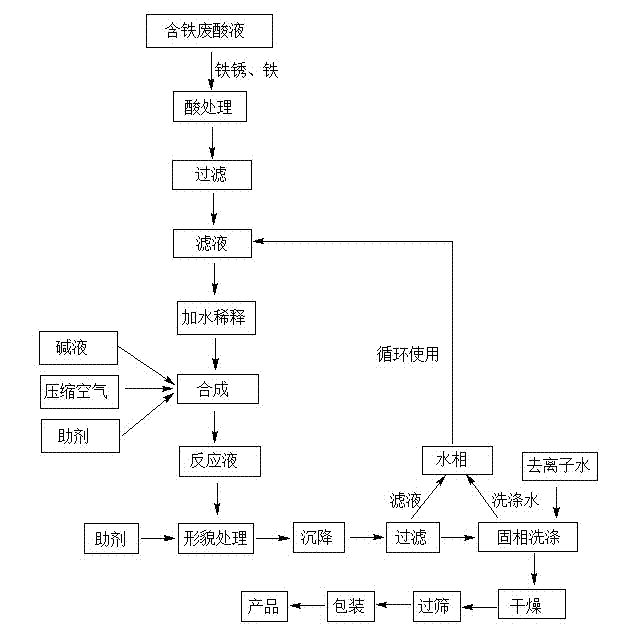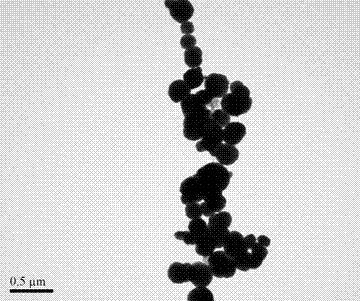Process for producing high magnetic ferroferric oxide by galvanized pickle liquor
A technology of galvanized pickling waste liquid and ferric tetroxide, which is applied in the directions of iron oxide/iron hydroxide, ferrous oxide, chemical instruments and methods, etc. It is difficult to popularize and apply problems, and achieve the effect of high added value, wide source of raw materials, and easy industrial production.
- Summary
- Abstract
- Description
- Claims
- Application Information
AI Technical Summary
Problems solved by technology
Method used
Image
Examples
Embodiment 1
[0049] Rust and iron were added to the iron-containing waste acid solution of a galvanizing plant to consume the free acid in the solution, and then filtered through a 800-mesh filter cloth. Transfer 240 ml of filtered filtrate to a reaction kettle, and add 160 ml of water to the reaction kettle for dilution. Turn on the heating device for heating, and turn on the stirring for slow stirring. When the heating temperature reaches 50°C, the stirring rate is controlled at 300r / min, and 3 mol L -1 200 ml of sodium hydroxide solution, the pH of the control solution is 6.0. Add polydimethyldipropylene ammonium chloride (0.5g) and 3-chloro-2-hydroxypropyltrimethylammonium chloride chitosan (0.5g) in turn to the reaction kettle. Air is introduced, and the air flow rate is controlled at 0.5 m 3 / h. When detecting Fe in the system 3+ with Fe 2+ When the molar ratio is 1.8, the aeration is stopped.
[0050] Add 20 ml 3 mol·L -1 Sodium hydroxide solution, control the pH of the solu...
Embodiment 2
[0054] Rust and iron were added to the iron-containing waste acid solution of a galvanizing plant to consume the free acid in the solution, and then filtered through a 800-mesh filter cloth. 480 ml of the treated filtrate was transferred to the reactor, and 320 ml of water was added to the reactor for dilution. Turn on the heating device for heating, and turn on the stirring for slow stirring. When the heating temperature reached 70°C, the stirring rate was controlled at 200r / min, and 3 mol L -1 205 ml of sodium hydroxide solution, the pH of the control solution is 6.5. 2-Hydroxypropyltrimethylammonium chloride chitosan (1.2 g) was added to the kettle. Air is introduced, and the air flow rate is controlled at 0.8 m 3 / h. When detecting Fe in the system 3+ with Fe 2+ When the molar ratio is 2.2, the aeration is stopped.
[0055] Add 20 ml 3 mol·L -1 sodium hydroxide solution, control the pH of the solution to 10.5, then add N, N , - Sodium dipalmitoyl ethylenediamine d...
Embodiment 3
[0059] Rust and iron were added to the iron-containing waste acid solution of a galvanizing plant to consume the free acid in the solution, and then filtered through a 800-mesh filter cloth. Transfer 240 ml of filtered filtrate to a reaction kettle, and add 160 ml of water to the reaction kettle for dilution. Turn on the heating device for heating, and turn on the stirring for slow stirring. When the heating temperature reached 85 °C, the stirring rate was controlled at 100 r / min, and 3 mol L -1 200 ml of sodium hydroxide solution, the pH of the control solution is 6.0. Add polydimethyldipropenyl ammonium chloride (0.7g) and iodide N-trimethylammonium chloride chitosan (0.8g) in turn to the reaction kettle. Air is introduced, and the air flow rate is controlled at 1.0 m 3 / h. When detecting Fe in the system 3+ with Fe 2+ When the molar ratio is 2.1, the aeration is stopped.
[0060] Add 20 ml 3 mol·L -1 sodium hydroxide solution, control the pH of the solution to 10, a...
PUM
 Login to View More
Login to View More Abstract
Description
Claims
Application Information
 Login to View More
Login to View More - R&D
- Intellectual Property
- Life Sciences
- Materials
- Tech Scout
- Unparalleled Data Quality
- Higher Quality Content
- 60% Fewer Hallucinations
Browse by: Latest US Patents, China's latest patents, Technical Efficacy Thesaurus, Application Domain, Technology Topic, Popular Technical Reports.
© 2025 PatSnap. All rights reserved.Legal|Privacy policy|Modern Slavery Act Transparency Statement|Sitemap|About US| Contact US: help@patsnap.com



